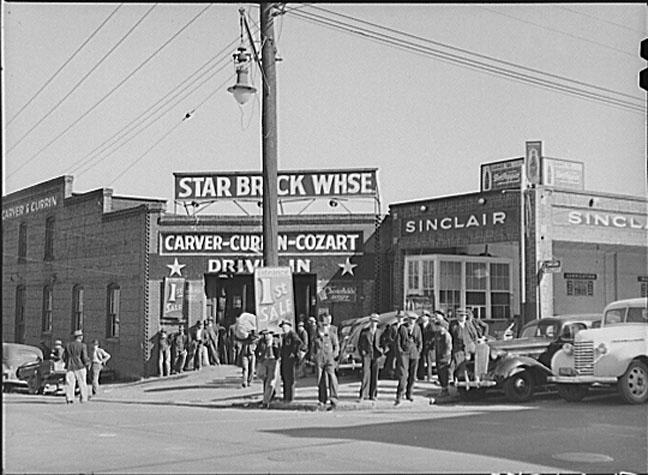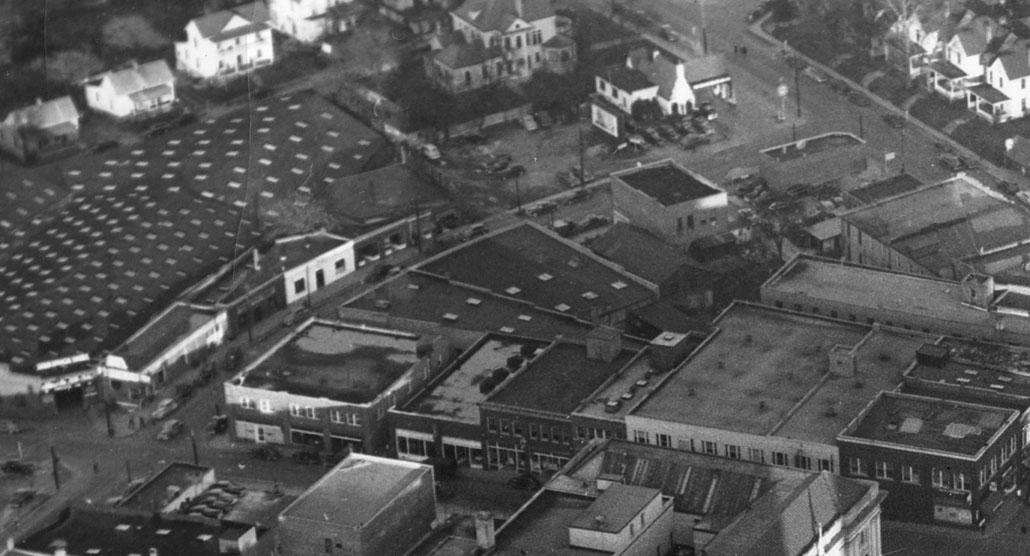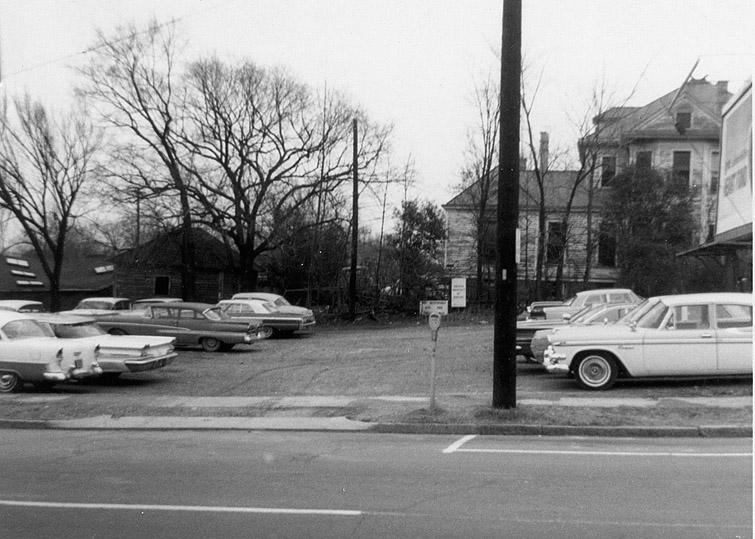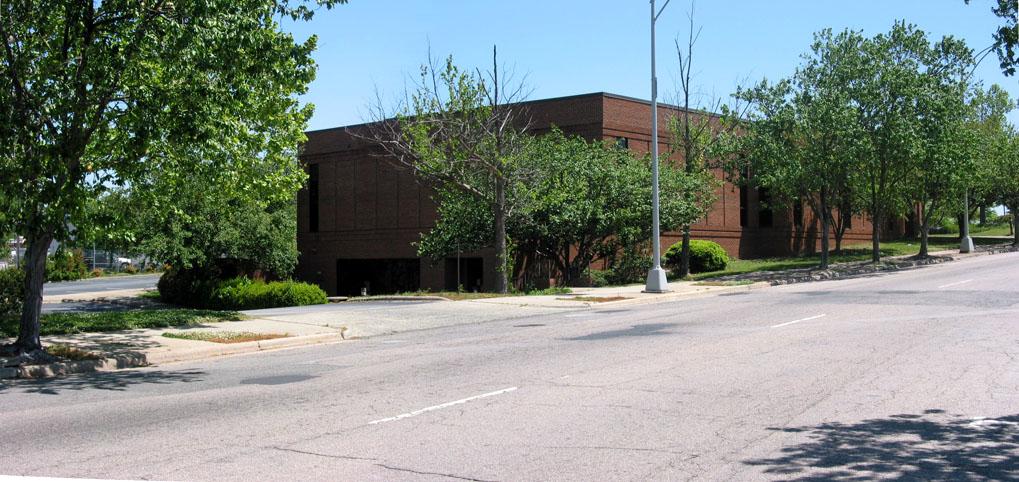Support OpenDurham.org
Preserve Durham's History with a Donation to Open Durham Today!
OpenDurham.org is dedicated to preserving and sharing the rich history of our community. Run by our parent nonprofit, Preservation Durham, the site requires routine maintenance and upgrades. We do not ask for support often (and you can check the box to "hide this message" in the future), but today, we're asking you to chip in with a donation toward annual maintenance of the site. Your support allows us to maintain this valuable resource, expand our archives, and keep the history of Durham accessible to everyone.
Every contribution, big or small, makes a difference and makes you a member of Preservation Durham. Help us keep Durham's history alive for future generations.






Comments
Submitted by Joe (not verified) on Fri, 7/13/2007 - 4:12am
What's the house in the upper right of the "102-104 Morgan" photograph? I think you can also see it in the upper part of your first photo.
Submitted by Gary (not verified) on Fri, 7/13/2007 - 11:23am
Joe
I'm still trying to figure that out myself, and yes, it's the same one in the upper photo. You'll see the best view of it (although still partial) in my next post. It would have been where Public Hardware is currently located. Unfortunately, that area of Mangum (high 400s to 500 block) is little photographed. Almost all of its houses were torn down, but not via urban renewal.
GK
Submitted by Anonymous (not verified) on Fri, 7/13/2007 - 2:01pm
This isn't directly related to this particular post, but I wanted to comment. I've been an endangered Durham reader for quite a while now and I have often heard (seen?) the impact that surface parking lots have in downtown areas.
I recently just got back from a week in Minneapolis visiting friends and was pleasantly surprised to see the compact, multi-use, streetscape-friendly, walkable, "livable" downtown areas. Even the area slightly outside of downtown - very residentially friendly places, although with streetscapes and integrated with gourmet grocery stores, coffee shops, pubs, clothing stores, etc - were similar.
NO SURFACE PARKING!
My friends told me it was because of the weather (in the winter), but it seemed nearly all of the parking there was in "ramps" - some above ground (aka parking garages) and some BELOW ground! (aka underground ramps).
I've always wondered why Durham (or other places) don't consider such parking set-ups, even if land can be acquired cheaply (it looks more aesthetically pleasant AND allows for the development of an uninterrupted streetscape).
For example - all 140,000 square feet of parking for the (new) Central Library in Minneapolis is completely under the building (see http://www.mpls.lib.mn.us/central.asp)
It's probably obvious from my posting that I am not an architect/urban planner/etc (just an ordinary citizen), but I'm curious as to your thoughts.
Submitted by Michael (not verified) on Fri, 7/13/2007 - 3:40pm
The simple reason is cost. A space of surface parking costs about 1/3 as much to build as a space of deck or underground parking (roughly the same cost for either -- it's building the structure that runs up the tab.)
The key thing that you need for decks to start to spring up (and Minneapolis has quite a few privately owned, for-profit decks) is for land costs to get too high.
I've gone on about this elsewhere, but one way that you can get lots of surface parking and still have an urban streetscape is on-street parking. (I go on about it for a while here
Submitted by John Martin (not verified) on Fri, 7/13/2007 - 11:06pm
Two points:
1) I'm not a car guy, but I'll be damned if I think these pictures are from 1966. In front of 122 Morgan, you've got what looks to be a late-forties Chevrolet and the car in front of 114 Morgan looks like a Packard or a Hudson. Now, obviously people drive old cars for long time. But you would expect one or two mid-sixties cars. I think these pictures may be late 1950's.
2) Michael, I really enjoyed your comment and I read the blog you referred to with a plan for a limiting surface parking lots. It was really thoughtful, intelligent, and creative. You and Gary are evidence that we have a lot of such people in Durham. To bad we can't import some of that into the city and county governments.
Submitted by Gary (not verified) on Sat, 7/14/2007 - 3:17am
Agreed Michael, although we have no shortage of parking deck construction. We're long past the point that we should be building bare decks on downtown streets. The one going up on Mangum is terrible.
Anon, I think the reason we don't do liner buildings (ramp-ups into hidden garages) is because everyone is deathly afraid that someone might have to search for parking spot, and this might dissauade one from coming to Durham/ a developer's project. I still think North Carolinians are incredible parking wimps. God forbid we should walk a few blocks.
John
I think you might have a southerly trip to take. I've linked the uncropped, date stamped photo for you. Thanks for the compliments of Michael and I. We'll do a joint filing for council, right Michael?
GK
Submitted by hovercraft (not verified) on Sun, 7/15/2007 - 4:20pm
The cars in the 106-108 Morgan photo are definitely mid-60s vintage--they weren't building that stuff in the 50s. They would have had fins, etc.
For reference, check out the 1966 Polara:
http://www.cruisintimes.com/FeatureVehicle.html
Submitted by Michael (not verified) on Tue, 7/17/2007 - 7:52pm
(Gary, you need a "recent comments" section on your blog -- I missed all this until now...)
Thanks for the nice words, John.
Gary, I want wrapped decks too, but I should point out that Minneapolis has its fair share of ugly, exposed decks, and the city fabric still works. Sure, it would probably work better with wrapped decks, but the abundance of decks helps make the city function.
At this point, I'm still in the mode of "any new deck is a good deck," mainly because I keep getting told that public transit won't work until the density increases. Well, that's kind of a self-defeating premise, but one way that you can actually increase density without public transit is with parking decks.
Submitted by Gary (not verified) on Tue, 7/17/2007 - 9:49pm
Michael - per your request. Well - the recent comments thing is a hack on Blogger - so I'm trying it out, but it's a lot uglier than the typepad version.
I'm not sure I completely follow your deck density comment. I think you're saying tha t we can cram more people in a small space if we have more abundant parking density as well. I would argue that we have plenty of parking already - it's just maldistributed.
Minneapolis may have ugly decks, but I don't think that's an argument to build ugly decks. I've never been, but my guess would be that the ratio of streetscape buildings to bare decks is a lot higher than Durham. If we are building buildings and building decks, why not hide the decks?
GK
Submitted by Christopher (not verified) on Thu, 2/4/2010 - 8:21pm
While the date-stamped photo did solve the mystery, it's quite an interesting collection of cars for 1966.
John is correct about the black car in front of 122 being late 40's era, though I think it's a Nash, and in front of 114 is certainly an early 50's Hudson. Some of the others date the era better though--in front of 118 is a '61 Dodge, the fin of a '59 Desoto is at the lower right of the 116 pic, and the lot at the end of the row contains 1960 and 1963 Chevrolets and a '61 Pontiac, as well as a mid 50's Oldsmobile and '55 Chevy. And the most fascinating, to a car geek like me at least, is the one in the lower corner of 106-108, which could be fully seen in the picture of 109 earlier in the week--early 60's Renault Caravelle coupe, a French import.
Submitted by Andrew Edmonds (not verified) on Tue, 8/17/2010 - 5:11am
The large house in the upper photograph seems to have been built around 1907. It was located at the southwest corner of Seminary and Mangum, in the current back parking lot of the Latino Credit Union -- and not on the current Public Hardware lot.
The city directories state that Charles L Haywood (of the "Haywood and King", then "Haywood and Boone" drug stores on West Main Street -- see Gary's entry below) lived there (at 419 N Mangum) by 1907 and through at least 1919. Others who lived there inclded Haywood's son (CL Jr.), daughter (Zola L), wife (Zoa), and domestic help (Annie Snipes and Violet Amey).
The 1907 Sanborn map shows the large footprint of this building. The 1902 Sanborn map shows that this lot formerly contained a different, yet still sizeable, structure.
The 1902 city directory identifies this older structure (415 N Mangum) as the "Roanoke Inn" boarding house. I am uncertain how long it was used for this purpose, but the house's original use was as the Baptist Female Seminary (later known as the Baptist Female Institute).
This school for girls is the source for the street name, Seminary Avenue. It was in operation by 1887, lasting for at least 5 years, according to the directories.
I learned all this while researching for the 3rd Annual Preservation Durham Ghost [building] Tour. Look for our flyers: we'll be examining the lost structures of Central Park this year.
--ASE.
Haywood and Boone:
http://endangereddurham.blogspot.com/2007/03/angier-corner-nw-corner-ma…
Submitted by Andrew Edmonds (not verified) on Wed, 8/18/2010 - 4:36am
Follow-up: Jean Anderson states that AM Rigsbee built the Baptist Female Seminary in 1881 (p. 171 of her Durham County book).
Add new comment
Log in or register to post comments.